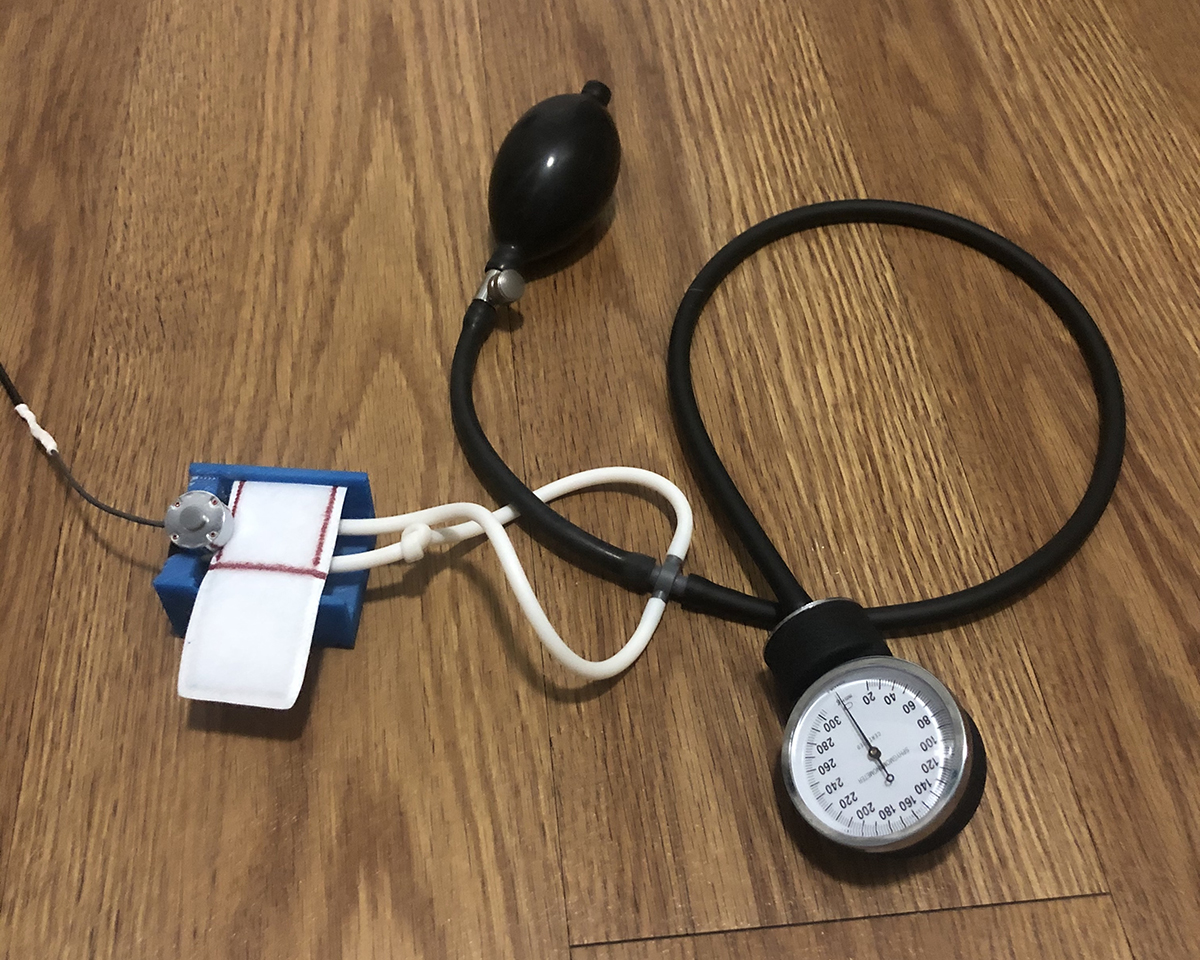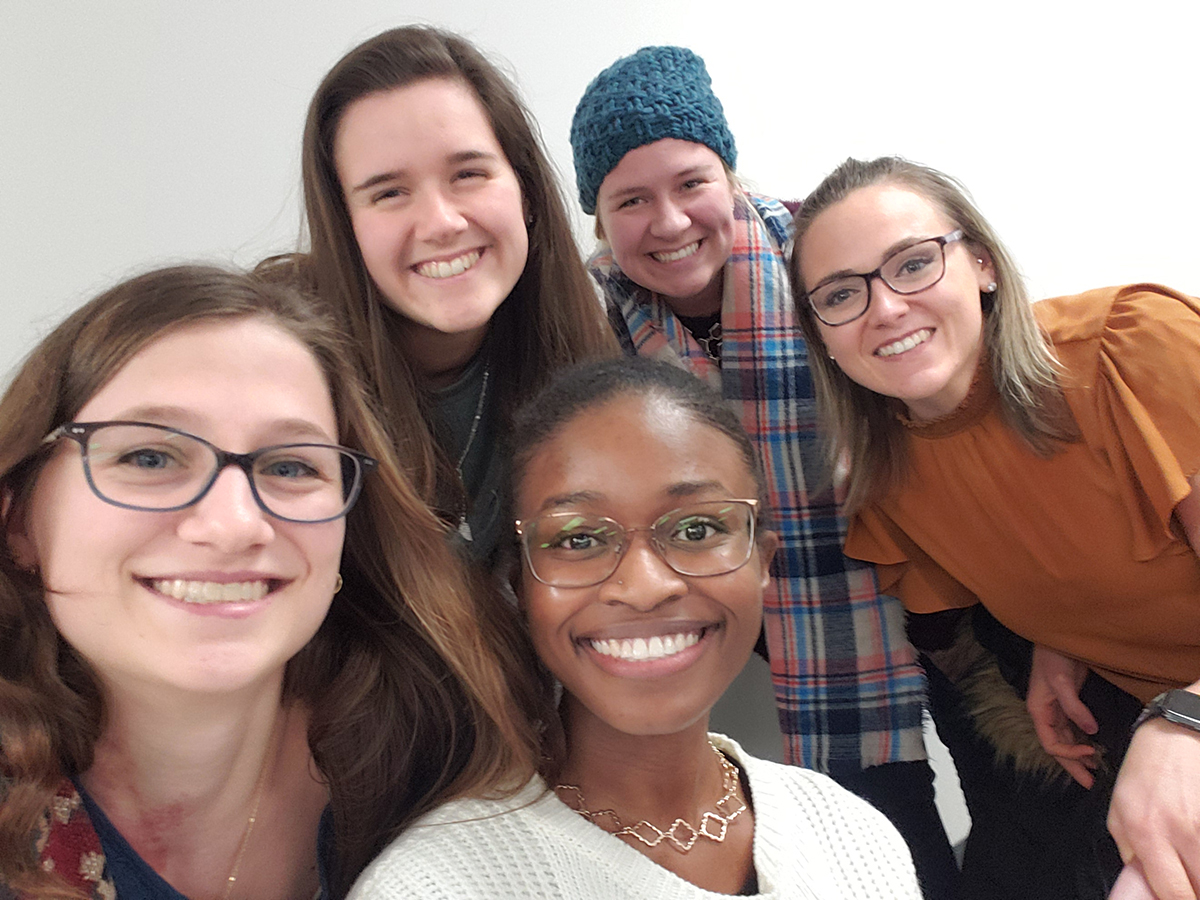Nineteen teams recently completed The University of Akron Research Foundation’s (UARF) I-Corps program, which helps novice entrepreneurs clarify who their customers are and what problems the new product or service can solve for those customers.

A prototype of the cuff-less blood pressure monitor created by the UA team members.
A group of senior biomedical engineering students at The University of Akron participated in the spring 2020 cohort of the program to further research into the development of a cuff-less blood pressure monitor. Team members Megan Laws, Allie Stephens and Alison Targosky answered some questions about their product.
Tell us about your product, the cuff-less blood pressure monitor.
“The monitor is a cuff-less device that will determine blood pressure noninvasively utilizing Korotkoff sounds. These Korotkoff signals are detected using a microphone module and filtering system. The cuff-less feature reduces the risk of product misuse and misplacement and allows for the device to be more comfortable for the patient. After further miniaturization, the product is expected to be wireless so that measurements can be taken easily without the need for excessive, bulky equipment.”
What influenced you to conceptualize a cuff-less blood pressure monitor?
“The original idea was conceptualized last summer at the 2019 Biomedical Engineering Society Coulter College design training program. The competition pushed the team to think outside of the box and create innovative solutions to pressing medical problems. Through several interviews with health care professionals, we saw a common issue with the typical blood pressure monitor’s cuff component. By using a cuff-less design, we were able to alleviate many of the issues that had been expressed with the current equipment.”

Team members of the cuff-less blood pressure monitor are the senior biomedical engineering students pictured above, from left in front, Jillian Savage and Arael Monroe. In the back row, from left, are Allie Stephens, Megan Laws and Alison Targosky.
As part of the I-Corps program, you had to interview potential customers for your product. Who did you interview for feedback? Was there anything that surprised you from the interviews?
“We began the interview process by speaking directly with health care workers that would be operating the device. These professionals had great insight about the pitfalls of current devices and the environments in which they are used. Blood pressure has what appears to be an infinite number of applications and we seem to uncover new settings that rely on blood pressure monitors with every interview. I-Corps encouraged us to interview more people that would have business insight, aka those with purchasing power. This got us to shift gears and interview people who are more involved with the supply chain, including purchase coordinators from various hospitals. As engineering students, we didn’t have a significant amount of experience with purchasing processes, so these interviews were very insightful when trying to determine our path to market.”
Where are you at now with the project?
“There is still a bit of development to complete on the device. Our most recent accomplishment was successful testing of the Proof of Concept Prototype. This testing proved that we can pick up on Korotkoff sounds without restricting an artery in the traditional manner with an arm cuff. With some design refinements, we will be able verify some critical outputs and miniaturize components for easier operation. To fund this development, the team has been spending the past several weeks since graduation applying to various design competitions and grants.”
How did the I-Corps program help you along this development journey? What was your biggest takeaway?
“I-Corps gave us the opportunity to further refine our target market by doing over 20 customer interviews. These interviews allowed us to explore different stakeholders and their input about what the problems are with current blood pressure monitors. The mentorship that I-Corps provided allowed us to investigate stakeholders we may have never even thought of, such as purchasing coordinators and buyers. The biggest takeaway from the program would be the development of our business model. This is something we were not familiar with prior to I-Corps, and with their guidance, we were able to develop a working business model canvas. I-Corps also shed the light on our device’s value. The original problem that we were solving was related to accuracy, but we didn’t realize that we can also save time for healthcare workers with this device.”
Your group was a recipient of the 2020 Lubrizol Life Science Health Design Awards. What was it like to get such recognition for your project?
“It was truly an honor and a testament of our hard work toward the project over the last year. Our 2020 graduating class had many talented teams that were solving significant problems, and to be selected as one of two winners amongst our class enunciates our dedication to this project’s success.”
Did the COVID-19 pandemic affect your research and development process?
“Yes, in mid-march, when Akron decided to continue the rest of the academic semester online, we knew that we were not going to be able to get the project to a place that we originally wanted by the time the team graduated. Without the ability to meet in person and physically develop the device, all design efforts were halted for our project. Even during I-Corps, it was difficult to obtain an interview with a health care professional because everyone’s time went toward COVID-19 relief. Fortunately, we were able to develop our business models and other aspects of the device that we could do virtually during this time.”
Group members: Senior biomedical engineering students Megan Laws, Arael Monroe, Jillian Savage, Allie Stephens and Alison Targosky
Media contact: Alex Knisely, 330-972-6477 or aknisely@uakron.edu.
